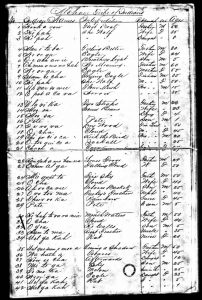Identity, Language Use and Naming Patterns
 This general substantive research area focuses on the interrelated topics of Identity, language use, and naming patterns. Of interest are both the use of English and the use of Native languages in American Indian life. Also of interest are the associated matters of identity and naming patterns. We are using Bureau of Indian Affairs data to document levels and trends of the use of Native and Euro-American names from the 1830s through 1885—as well as social characteristics associated with different naming patterns. We are also using decennial census data to examine the ways people with Native ancestry identify themselves as American Indian, as well as changes in patterns of American Indian identity in the 20th century.
This general substantive research area focuses on the interrelated topics of Identity, language use, and naming patterns. Of interest are both the use of English and the use of Native languages in American Indian life. Also of interest are the associated matters of identity and naming patterns. We are using Bureau of Indian Affairs data to document levels and trends of the use of Native and Euro-American names from the 1830s through 1885—as well as social characteristics associated with different naming patterns. We are also using decennial census data to examine the ways people with Native ancestry identify themselves as American Indian, as well as changes in patterns of American Indian identity in the 20th century.
Project 3.01: Names Used Among Native Americans at the Colville Indian Agency: Perspectives from the 1885 Bureau of Indian Affairs Census.
Jillian Gordner, Arland Thornton, and Linda Young-DeMarco
Abstract
In this study we examine the types and frequency of names used among American Indians in a Bureau of Indian Affairs (BIA) census conducted by the Colville Indian Agency in 1885. Innthe 1885 Colville census both Native and Euro-American names could be recorded, and our analysis shows that one-quarter of the people were recorded with only a Native name, just under two-thirds were recorded with only a Euro-American name, and just over one-tenth were recorded with both a Native and Euro-American name. Of those Natives reported with a Euro-American name, just over five-sixths were recorded with a traditional Euro-American name. In addition to documenting the overall frequency of various types of names, we examine how these patterns vary by gender, birth cohort, and Native group. Our results show that the frequency of reporting a Native name declined from about seventy percent to just over ten percent across the birth cohorts from 1790–1815 to 1876–1885 while the reporting of traditional Euro-American names increased substantially from about forty percent for the birth cohort of 1790–1815 to about eighty percent for the 1866–1875 birth cohort. There were also sharp distinctions in the frequency of Native and Euro-American names recorded for the different groups. Whereas the names recorded by one specific group were entirely Euro-American, with no Native names, in another group, only a third were recorded with Euro-American names and nearly one-hundred percent were recorded with a Native name. We discuss possible explanations for the differences across gender, across birth cohorts, and across groups, with particular emphasis on the nature of interactions with Euro-Americans.
